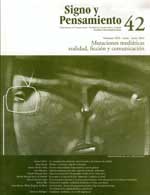Abstract
En este artículo se analizan las principales fuentes y consecuencias de producción, distribución y recepción entre los dos grandes géneros que dominan actualmente la programación internacional de televisión: las series de ficción y los formatos de la tele realidad. Se afirma que en la serie de ficción (telenovela, comedia, policial) asistimos a una concatenación de escenas y transformaciones de hechos y de personajes, pero como todo ello ya ha sucedido en otro tiempo real, la serie viene consumida por el espectador como un objeto de representación inerte de los espacios sociales (hogar, trabajo, la calle, la escuela, el hospital, etc.). En los programas de tele realidad, el encadenamiento de secuencias y los cambios que observamos en el devenir narrativo del acontecimiento mostrado en directo (diferido o simultáneo) de lo social y en los personajes se hace como un proceso en acto durante la observación de los espectadores.This journal is registered under a Creative Commons Attribution 4.0 International Public License. Thus, this work may be reproduced, distributed, and publicly shared in digital format, as long as the names of the authors and Pontificia Universidad Javeriana are acknowledged. Others are allowed to quote, adapt, transform, auto-archive, republish, and create based on this material, for any purpose (even commercial ones), provided the authorship is duly acknowledged, a link to the original work is provided, and it is specified if changes have been made. Pontificia Universidad Javeriana does not hold the rights of published works and the authors are solely responsible for the contents of their works; they keep the moral, intellectual, privacy, and publicity rights.
Approving the intervention of the work (review, copy-editing, translation, layout) and the following outreach, are granted through an use license and not through an assignment of rights. This means the journal and Pontificia Universidad Javeriana cannot be held responsible for any ethical malpractice by the authors. As a consequence of the protection granted by the use license, the journal is not required to publish recantations or modify information already published, unless the errata stems from the editorial management process. Publishing contents in this journal does not generate royalties for contributors.


